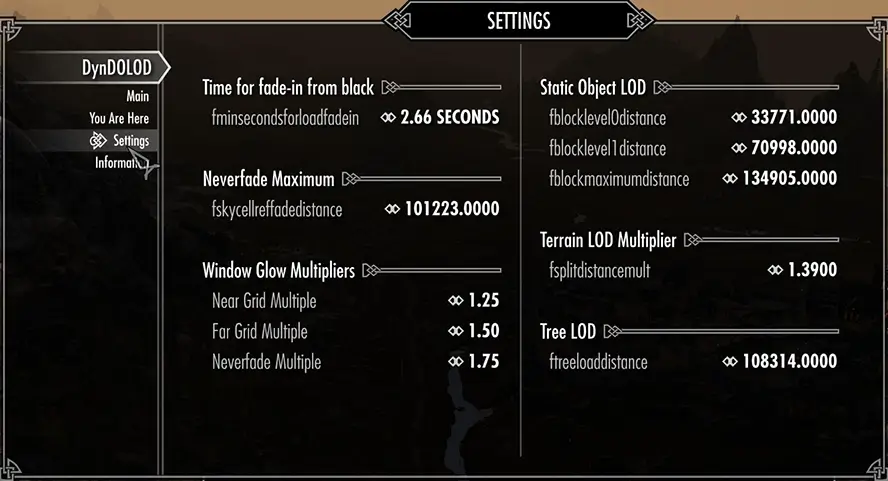Glow LOD is a combination of different types of objects that one way or the other emit light. While fires are added with the default 'Low', 'Medium' and 'High' rules, additional Glow LOD settings need to be enabled in the advanced or expert option windows.
Basically, the glow shader allows two types of glow: own emit or external emittance. While own emit never changes strength or color of the glow, external emittance glow is controlled via Creation Kit settings that can change over time and on other parameters. This can be used to make windows only glow at night and react to sunlight. This behavior is controlled per reference, which means the same mesh can be used for either type, because external emittance takes precedence over the own emit color settings.
Object LOD generated by LODGen 'only' supports own emit. Neverfades and thus dynamic LOD supports external emittance as well.
All Glow LOD color and intensity is affected by weather and lighting region settings. The vanilla game or other mods modify those settings, but typically until now they only cared about glowing windows and such within the attached cells. If Glow LOD seems dim or too bright at times, it is the weather and lighting settings and other factors outside the control of DynDOLOD. However it is also possible to edit the Glow LOD meshes directly.
Intensity of fires can be controlled via ENBs fire settings.
Using glow LOD may exaggerate decal and environment map fade. For example, details on dirtcliffs fading out much closer or waterwheels appearing less wet/darker. This can be fixed in Skyrim.ini"
[LightingShader]
fDecalLODFadeEnd=1.0000
fDecalLODFadeStart=1.0000
fEnvmapLODFadeEnd=1.0000
fEnvmapLODFadeStart=1.0000Load Rules For Candles

Candle flames are a shader based on a certain mesh setting and can also simply be done as dynamic LOD. Use the advanced mode and check the Candles option, then either click Low, Medium or High to load additional rules for the candles. The Low and Medium rules adds candles in the NearGrid, while the high rules add them to the FarGrid.
Intensity of candles can be controlled via ENBs particlelights and lightsprite settings.
Load Rules For FXGlow

Fxglow meshes are round meshes always facing the player. They have an alpha texture that emits light, thus emulating lit up air around a light source. Check the FXGlow option, then either click Low, Medium or High to load additional rules for the fxglow meshes. The vanilla game comes with a number of fxglow meshes with different glow strength. Depending on Low, Medium or High first the rules for the extra bright, then bright and then medium fxglow meshes are added. Typically low adds them to the NearGrid, medium to both depending on strength and high adds all rules to the FarGrid.
Intensity of fxglow meshes can only be controlled by editing the nif files in ..\Meshes\DynDOLOD\lod\effects\fxglow[fill|flat]*_dyndolod.nif
Windows

Checking Windows in the advanced mode option adds glowing LOD windows to all vanilla LOD buildings. Glowing LOD windows are independent meshes that are added in addition to the LOD of the object they belong to. If the High checkbox is not checked, the glowing windows are added as object LOD only. Checking High adds glowing windows as dynamic LOD if applicable. As explained above, dynamic LOD windows react to external lighting. However, windows on vanilla forts for example are not using external emittance and consequently will always be generated as object LOD. A reference only uses external emittance if the XEMI - Emittance entry links to a region.
Most windows are automatically added to the FarGrid, some are added as neverfades that always show regardless of distance. This is determined by the *glow_lod_X.nif filename. If X equals _0 it is assigned to NearGrid (LOD Level 4), _1 to FarGrid (LOD Level 8) and _2 (LOD Level 16) is a neverfade.
Intensity of glow LOD Windows can be controlled via ENBs windowlight settings.

If NetImmerse Override (also included in RaceMenu) is installed, glow LOD Windows which are done as dynamic LOD automatically increase their intensity multiplier based on NearGrid, FarGrid and true Never Fade distance. The DynDOLOD SkyUI MCM can be used to control this feature and change the multiplier amount for each step.
Fake Lights
Light sources that light up objects / textures can not be done as true LOD. By using fxglow meshes such lights can be emulated to a degree. Lights eligible need to have a radius larger than a threshold and have their neverfade flag set. The threshold for the radius can be controlled in ..\DynDOLOD\Edit Scripts\DynDOLOD\DynDOLOD_[GAME MODE].ini by changing FakeLightsMinScale and FakeLightsChildWorldMinScale. The neverfade flag on light sources in this context means the effect of the light is visible across all attached cells, but not beyond them.
The intensity of the fake light glow mesh can be controlled by setting FakeLightsIntensity in ..\DynDOLOD\Edit Scripts\DynDOLOD\DynDOLOD_[GAMEM ODE].ini from 1 = low to 9 = high.
While the switch from FXGlow LOD to a real light is quite noticeable since the two are complete different things, the FXGlow LOD adds a nice simulation of lights lighting up the air and objects behind it. This works well when looking into cities with a load door.
Check Fake lights selected world to add FXGlow LOD in place of lights in the world that LOD is generated for. Again, this might not work very well and look off when approaching the light source. Typically, leave this unchecked.
Check Fake lights child worlds to add FXGlow LOD in place of lights in the child worlds of the selected world that LOD is generated for. This adds the FXGlow LOD to the major cities when looking in from the outside.
FXGlow LOD for fake lights are always added to the FarGrid.
Intensity of the default fxglow mesh can only be controlled by editing the nif file in ..\Meshes\DynDOLOD\lod\effects\fxglowdefault_dyndolod_lod.nif